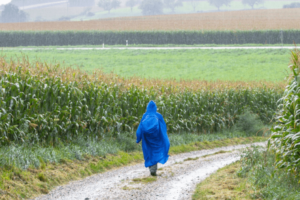Base layer and mid-layers are important to stay warm, but if you’re walking in the UK countryside, you’ll need a waterproof jacket as it doesn’t half like to rain in the UK. Like many hikers, I take a day rucksack everywhere I go and a key item in my day-rucksack, is my waterproof jacket.
One of the questions I get asked the most on this website is how to choose a waterproof jacket. The honest answer, it’s not be as easy as you think. The problem faced when trying to buy the right waterproof jacket, is striking the correct balance between the level of water-resistance and breathability that is required.
Breathability Vs. Waterproofness
You would think that in an ideal world, you would simply buy a plastic type jacket that is 100% waterproof, and all will be well. The issue is that 100% waterproof jackets are 0% breathable. This means they will not release any of your perspiration, meaning that you’ll end up soaked in sweat.
In contrast, you could end up purchasing a jacket that is fully breathable yet not waterproof. However, this would defeat the object of having a waterproof jacket. Also, once it starts to get wet, will get heavy, very quickly and if you’re staying in a tent, overnight, you could have real problems trying to dry your wet jacket.
In all honesty neither a fully breathable, or a totally waterproof jacket would be ideal for hiking in the UK countryside.
Breathability Vs. Water Resistance
Ideally, we want to balance both breathability and the level of water resistance required against what the jacket is intended for. If you are buying the jacket with the intention of going hiking this summer in, for example, the Exmoor National Park, it is more than likely that you are going to want a day-jacket that offers more breathability as opposed to a high level of water resistance.
In Devon, it of course rains, but the temperature does not generally drop low enough to be deemed as cold. You would therefore want a waterproof jacket that will keep you dry should it rain, but also offer a high level of breathability so that you are not left feeling uncomfortable by your inevitable perspiration as you walk across the hills.
In comparison, if you are hiking in the Scottish mountains during the winter, it is highly probable that your main objective is to remain as dry as possible and you will therefore be willing to sacrifice some level of breathability to ensure this. Getting wet can not only make for an uncomfortable walk, but it will also quickly make you feel cold and miserable.
Waterproof Jacket Ratings
You can determine how watertight a jacket is based on the waterproof rating it has been given. The higher the rating, the longer the fabric will remain waterproof. An important point to bear in mind is that a jacket is never going to be 100% waterproof unless the jacket has been designed with taped seams. If the seams are not taped, you can be assured that the jacket will begin to leak at some point in the future, most probably when you need it most.
There are key ratings that you should be aware of and should be given due consideration when looking to purchase your next waterproof jacket. In the UK, the minimum British standard set for an item to be considered as waterproof is 1,500 mm. Anything less, and the item cannot be marketed as waterproof. However, realistically, if you are in the countryside wearing a 1,500mm jacket and it starts to rain, you are going to get wet.
The lowest rating is given to jackets intended for water and snow resistance only, which can merely withstand light rain. The highest ratings (5,000 – 10,000mm) are awarded to those intended for extreme wet weather and are ideal for water pursuits such as canoeing and sailing. To ensure that standards are being met and maintained, factories test each jacket using a hydrostatic head test that measures how much water the outer shell of the jacket can hold before it leaks through to the inside.
This is expressed in the table found below:
| Waterproof Rating (mm) | Water Resistance Provided | Usable Conditions |
|---|---|---|
| 0 – 1,500 mm | Very litte | 1,500mm is the legal requirement in the UK, but you can hardly call it waterproof. |
| 1,501 – 10,000 mm | Rainproof | The top end of this scale get a fully waterproof jacket that will keep you dry in everything but the heaviest of rain. |
| 10,001-15,000 mm | Waterproof | When jackets are above 10K, we’re into the range where they’re totally waterproof in even the heaviest of rain |
| 15,001-20,000 mm | 100% Waterproof | Above 15K and we move into dry-suit territory. The only way water get through a dry suit top, is your seal start to leak. |
| 20,000 mm+ | Very Good | Above 20K and we’re talking about dry suits that deep sea divers wear to work at the bottom of the ocean. |
Breath-ability
As previously mentioned, if you are looking to invest in a good weatherproof overall this year, you should concern yourself with its breathability as well as its waterproof rating. A numerical rating will be applied which, in simple terms, pertains to the number of grams of water vapor that can be passed through the fabric in a period of time. Basically, the larger the number, the more breathable the fabric is deemed to be.
This is expressed in the table found below:
| Breathability Rating (g) | Breathability Provided | Usable Conditions |
|---|---|---|
| 0 – 3,000 (g) | Very Little | There’s no legal requirement in the UK, however anything below 3K grams is basically not breathable. |
| 3,000 – 5,000 (g) | Litte | |
| 5,001- 13,000 (g) | Average | |
| 13,001-18,000 (g) | Good | |
| 18,001+ (g) | Very Breathable |
Types of Water Proof Jacket
There are 4 main types of water proof jackets; two layer water proof jackets, three layer water proof jackets, 3 in 1 water proof jackets and pakka water proof jackets.
- A two layer waterproof jacket, the most common of the four, has, as the name suggests, two layers. The outer layer or shell prevents the rain from soaking into the coat and the inner layer or liner helps to maintain the outer part by creating a shield between the shell and the owner’s sweat and movement.
- A three layer waterproof jackets contains one extra layer – another protective lining to safe guard the jacket from torrential rain.
- A 3 in 1 water proof jacket doesn’t have the protective layer of a 3 layer water proof jacket, but does have a fleece on the inside that will keep you warm when the temperature drops.
- A Pakka jacket is a foldable lightweight waterproof jacket that you pack away in it’s own small pouch and small enough to put in the side pocket of your bag. It may not be as fully water proof as the others, but it is perfect in changeable weather.







